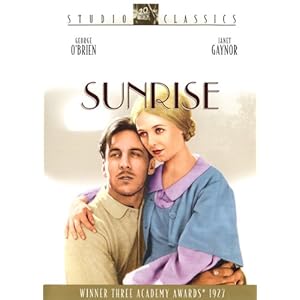
Usually when I watch a classic silent film, I'm impressed by the importance it holds in the evolution of cinema but I don't actually enjoy it that much. That isn't the case with Sunrise, which is now definitely my favorite movie of the era. Its gigantic shifts in tone at various points are a bit odd, and you have to think a more modern take on the story would blend those different elements a bit more gracefully. But it's still a great film, important stylistically and still emotionally effective today.
Based on the description I read, I expected the general arc of the plot to be a bit different. It's about a couple living in the country whose marriage is interrupted when the man is seduced by a woman from the city. I expected it to establish the marriage early, break it up in the second act, and then reconcile them in the third. But it opens with the husband already in the city woman's clutches, and within the first ten minutes she's asking him to kill his wife, sell the farm, and move with her to the city. The story focuses almost entirely on the couple from that point forward, as they go through what is surely the most eventful day of their lives. There are scenes filled with surprisingly effective tension and dread, some devastating emotionally, and others wonderfully romantic. The middle has some almost confusingly broad comedy, including a scene where I'm pretty sure they actually got a pig drunk based on how realistically it was stumbling around, but it doesn't take the story completely off the rails so it gets a pass.
Janet Gaynor won an Oscar for her performance as the wife (along with a couple other movies as the first woman to get the award), and both of the lead performances are really quite effective considering the complete absence of dialogue. The film would work just based on the story and acting alone, but it's improved a great deal by the German director F.W. Murnau's extra touches that make the film seem quite ahead of its time. His photographers pioneered some really good tracking shots and there's a lot of well-done (for the time) compositing of multiple images, used in many different ways to dramatic effect. I even liked the subtitles, which actually have a personality and are used to convey the mood of the story beyond just putting dialogue on the screen. It's an old movie that feels a lot newer thanks to the quality of both its style and substance, and definitely one of the best products of the 1920s.
AAAAAGGGHHHH
16 years ago


































No comments:
Post a Comment